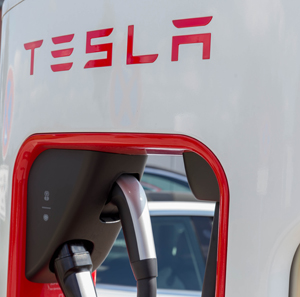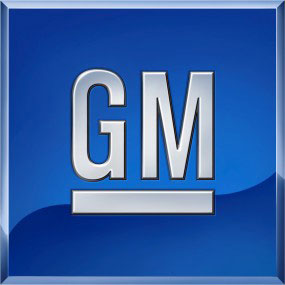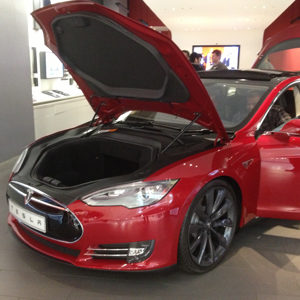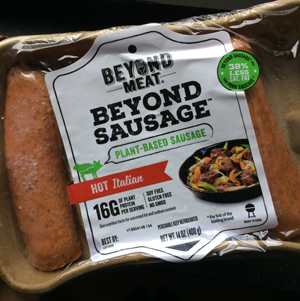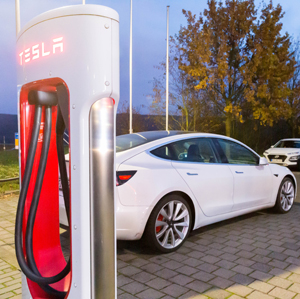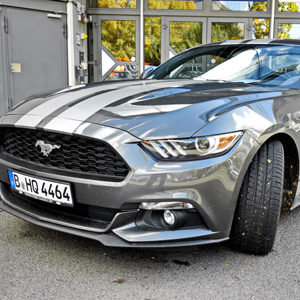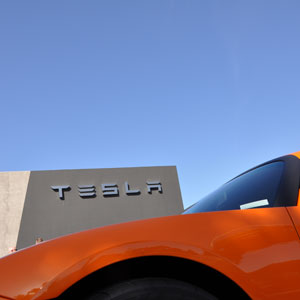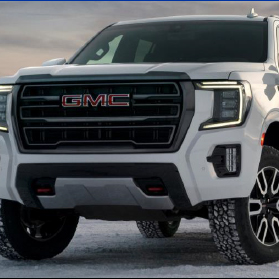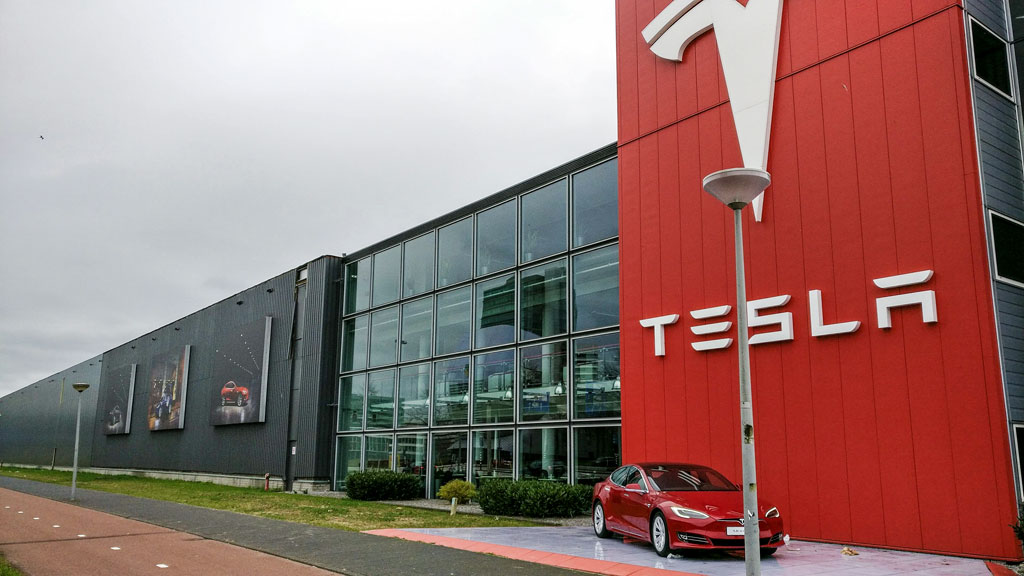
A Tesla Sales and Service location. Flickr Image.
- General Questions
- Vehicle Sales Related Questions
- Model Y Related Questions
- Self-Driving Vehicle Related Questions
- Tesla China Related Questions
- Energy Generation and Storage Related Questions
- Balance Sheet Related Questions
- Cash Flow Related Questions
- Revenue Related Questions
- Profitability Related Questions
- Business Acquisition Related Questions
General Questions
1. What is the bull case of investing in Tesla stocks?
According to Tesla update letter dated 4Q18, for the past two years from 2017 to 2018, Tesla electric vehicles have accounted for all the electric vehicle volume growth in the US. Even with that growth, the current electric vehicles market only accounts for just 2% of the total US market. As such, there remains a substantial opportunity for electric vehicles to gain market share in the US and globally. Moreover, Tesla claimed that electric vehicles in Q4 2018 has outsold hybrid electric vehicles in the US for the first time in history, demonstrating that electric vehicles are becoming a preferred option among consumers.
In addition, Tesla trade-in data shows that consumers are significantly changing their purchasing habits in order to buy a Model 3. Out of all the trade-ins Tesla has received, 60% of these trade-ins are non-premium vehicles, suggesting that the appeal of Model 3 goes far beyond the mid-sized premium sedan market. The company is also seeing a significant number of Model 3 buyers are trading down in size from a larger car or a SUV to a Model 3.
In short, there is a huge market of electric vehicles not only in the US but also worldwide waiting for Tesla to address.
2. Where are most of Tesla electric vehicles and their components manufactured?
They are manufactured in facilities located in multiple locations such as Fremont, California, Lathrop California, Tilburg, Netherlands, and Gigafactory 1 in Reno, Nevada.
3. Where is Tesla Solar Roof manufactured?
Solar Roof production was started in October 2016 and is done at Gigafactory 2 in collaboration with Panasonic in Buffalo, New York.
4. What are the business segments of Tesla?
Tesla operates in two segments: automotive and energy generation and storage. The automotive segment includes the design, development, manufacturing, and sales of electric vehicles.
The energy generation and storage segment includes the design, manufacture, installation, and sale or lease of stationary energy storage products and solar energy systems, and sale of electricity generated by the company solar energy systems to customers.
To find out more detail about the business segments, please visit this page: Tesla Business Segments
5. How many employees does Tesla have?
Based on the 2018 annual report, Tesla has 48,817 full time employees as of December 31, 2018. Based on the 2017 annual report, Tesla has 37,543 full time employees as of December 31, 2017.
6. When was Tesla shares started trading on the NASDAQ?
The common stocks of Tesla began trading in the NASDAQ under the symbol “TSLA” since its IPO in June 29, 2010.
7. What is the dividend policy of Tesla?
Based on the latest annual report, Tesla has never declared or paid cash dividends on its common stock. Besides, the electric automaker does not anticipate paying cash dividends in the foreseeable future.
8. What was the price of Tesla share during its IPO?
Tesla initial public offering (IPO) was priced at $17 (USD) per share on June 29, 2010.
9. How does Tesla improve its vehicle manufacturing efficiency?
The company improves its vehicle manufacturing efficiency through its increasing experience and learning from past and current product ramp. For example, Tesla uses a metric called capital efficiency per dollar spend to measure its vehicle manufacturing efficiency. This metric measures how much capital is utilized for a unit of vehicle produced.
Consequently, based on the experience and learning from the Model 3 ramp, Tesla is striving to improve the capital spend per unit of Model 3 at the Gigafactory Shanghai and expects that this metric would be a lot less compared to the manufacturing line at the Tesla Factory in Fremont.
Moreover, Tesla also improves the capital efficiency per dollar spend through the sharing of components between Model Y and Model 3. Because of the similarity between the components of Model Y and Model 3, the company can ramp the production of Model Y significantly faster than that of Model 3 and at the same time improve the cost per unit of manufacturing capacity for Model Y compared to that of Model 3 in Fremont.
10. What kind of partnership does Tesla have with Panasonic?
Tesla is partnering with Panasonic on Gigafactory 1 with investment coming from both companies in the production equipment that Panasonic uses to manufacture and supply Tesla with battery cells. The partnership between Tesla and Panasonic is under the arrangement that Tesla will purchase all the battery cells from Panasonic at negotiated prices. As such, in accounting terms, the arrangement is accounted for as a finance lease. This results in Tesla capitalizing all the costs of investment in the production equipment as asset in the balance sheet. In addition, there is a corresponding liability recorded for these production equipment under long-term debt and finance leases.
11. How efficient are the Model X and Model S electric vehicles compared to its competitors?
In Q1 2019, Tesla has updated the Model X and Model S electric vehicles with the latest powertrain. As such, these models are now having the longest range and better performance. For example, Model S is now having a 370-mile (EPA) maximum range whereas the Model X is now having a 325-mile (EPA) maximum range. Both models remain the longest-range electric vehicles in the world.
From Tesla 1Q19 update letter, Model X is beating all other SUV electric vehicles efficiency by a wide margin. For example, Model X is having an efficiency of 3.3 miles/kWh whereas its closest competitor is only having efficiency of about 2.1 to 2.6 miles/kWh.
12. Why is the wait time for Model 3 so much shorter than Model S and Model X?
The reason is that Tesla is mass producing Model 3 and the production is done in batches to build different variants of Model 3 in high volume. As such, customers do not need to wait for the vehicle to go into production when the orders are completed like what is being done for Model S and Model X. Instead, their orders are matched instantaneously to the Model 3 variants in the company inventory. Once a match is found the delivery of the vehicle is done right away. The only wait time for Model 3 is the delivery time of the vehicle to customer destination.
13. What is the difference between Tesla vehicle deliveries and production??
Tesla vehicle deliveries refers to vehicles that have been sold to customer. In accounting terms, the transaction will be recognized only as sales when the transfer of risks and rewards of the vehicles to customers have been completed. Only then the company can recognize revenue based on the vehicle deliveries data.
On the other hand, vehicle production refers to the number of vehicles the company has manufactured in its Gigafactory plant. The vehicle produced will not be recognized as revenue since they have not been sold yet. Instead, they will be accounted for as inventory in the company balance sheet.
14. Where does Tesla manufacture the battery cells for both electric vehicle and energy storage?
Tesla battery cells are mainly produced at Gigafactory 1 in Reno, Nevada. The production of battery cells is done with Panasonic with investment coming from both companies in production equipment that Panasonic uses to manufacture the battery cells.
15. How does Tesla reduce vehicle transportation time and improve the timeliness of scheduled deliveries?
Tesla has bought a whole lot of car-hauling trucks for vehicle shipments. Instead of sourcing the job of vehicle delivery to any third party, Tesla is taking control of the shipment itself and claims that it not only can lower transportation cost but also improve customer satisfaction.
16. Did Elon Musk purchase any Tesla common stocks in any public offering?
The answer is yes. According to the 2Q 2019 quarterly filing, Elon Musk purchased 102,880 shares of Tesla common stock in a public offering on May 2019 for an aggregate $25 million. The average purchase price for this transaction is roughly $243.
Vehicles Sales Related Questions
1. How many vehicles does the company expect to sell in 2019?
Tesla has given guidance to investors that it expects to sell between 360k and 400k vehicles (all models) in 2019.
2. Where does Tesla manufacture the Model 3?
Model 3 is produced at the Tesla Factory in Fremont, California and its related battery unit is produced at Gigafactory 1 in Reno, Nevada.
3. How many units of Model 3 has been sold by Tesla?
Tesla has produced 254,530 units of Model 3 and sold 245,506 Model 3 for the entire year of 2018 based on its 2018 Annual Report.
Tesla has sold 1,764 Model 3 in the entire year of 2017 based on its 2017 Annual Report.
If you are interested in tracking the quarterly vehicles sales data, please visit this page: Tesla Vehicles Sales Data.
4. How many units of Model S and Model X has Tesla sold?
For the entire year of 2018, Tesla sold 99,475 units of Model S and Model X vehicles combined according to its 2018 annual report.
Tesla doesn’t break down the figure for each Model S and Model X sold but the combined number is 101,420 units for both models in 2017 according to its 2017 Annual Report.
5. Which Tesla model is the best selling model?
Model 3 is the best selling model, achieving a production of 254,530 vehicles and deliveries of 245,506 vehicles in 2018 alone.
6. Why did Tesla create the Model 3?
The Model 3 is designed to be a lower-priced sedan targeted for the mass market so that the adoption of electric vehicles can be sped up.
In 1Q 2019, Tesla has introduced a less expensive variant of Model 3, starting with a base price of just $35,000.
The $35k Model 3 has a spec of 220 miles of range, 0-60mph at only 5.6second, over the air update and same 5-star safety rating as the longer-range version of Model 3.
7. Why did Tesla discontinue the new custom order for the 75kWh version of Model S and Model X in 4Q18?
In 4Q 2018, Tesla had discontinued the 75kWh version of Model S and Model X to focus on the performance version of the Model S and Model X such as the longer range version.
Besides, the company wanted to have differentiation between the recently launched Model 3 and Model S and X so that
sales of Model 3 won’t be cannibalized by the lower range version of Model S and X.
In addition, Tesla wanted to save cost by adopting standardization across these models when the company is increasingly becoming efficient in production by using automation.
8. Did the discontinuation of the 75kWh version of Model S and Model X in 4Q18 affect vehicle demand in subsequent quarters?
Yes, delivery for Model S and Model X fell off the cliff in 1Q19. Only 12k units of both Model S and Model X were delivered in 1Q19.
9. Why did the delivery and production of Model S and Model X fall so much in 1Q 2019
The reason is the company had stopped taking orders for the 75kWh versions of Model S and Model X since 4Q18. Tesla will only sell the performance version (longer range such as the 310 miles for Model S and 270 miles for Model X) of Model S and Model X. Hence the higher price of both Model S and Model X has caused the decline in demand for these flagship models.
10. Why is Tesla pledging not to initiate any lawsuit against any party for infringing the company patents in electric vehicles and battery technology?
Tesla made this pledge in order to encourage the advancement of a common, rapidly evolving platform for electric vehicles, thereby benefiting Tesla itself, other automakers of electric vehicles and the world.
11. How much federal tax credits are available for the purchase of a qualified electric vehicles in the US?
For vehicles sold in 1st and 2dn quarter of 2019, federal tax credits will be $3,750.
For vehicles sold in 3rd and 4th quarter of 2019, federal tax credits will be $1,875.
For vehicles sold after 2019, federal tax credits will be $0.
12. What types of warranty does Tesla provide for the purchase of a new Model 3 vehicle?
Based on the March 31 2019 quarterly filing, Tesla provides a 4-year or 50,000-mile limited warranties for the purchase of a new Model 3 vehicle. The battery and drive unit of a new Model 3 vehicle are subject to a separate limited warranties.
As a result, for the battery and drive unit of a new Model 3 vehicle, Tesla provides a separate 8-year or 100,000-mile limited warranty for the Standard Range, Standard Range Plus or mid-range battery. For the long-range battery, Tesla provides an 8-year or 120,000-mile limited warranty. All battery ranges of a new Model 3 vehicle are covered with a minimum 70% retention of battery capacity over the warranty period.
13. What is the wait time for Model 3?
Unlike Model S and Model X, Tesla does not build Model 3 vehicles according to order. Instead, the company builds different variants of Model 3 in batches and every vehicle that leaves the factory would be stored in a warehouse as inventory. These vehicles are then matched with specific orders made by customers. Once the specs and orders are matched, the vehicles are delivered to customer right away. With that said, the wait time for Model 3 is so much shorter and is only the delivery time that the vehicle takes to reach the customer destination.
14. Why is the wait time for Model S and Model X can be a few months long or even years?
The reason is that these models are considered premium vehicles and are only going into production when orders are received. For example, when customers have completed customizing the specifications of the vehicles according to their requirements and have paid a booking fee. Tesla does not carry any completed Model S and Model X that you could buy right off the stores or even if the company carries such models which are ready for sale, the inventory for these models are very limited.
Model Y Related Questions
1. How much will the Model Y be priced?
Based on the 1Q19 Tesla update letter, the expected sale price of Model Y will be around $48,000 for the long-range version.
2. What are the selling points of the Model Y?
The Model Y will be an all-electric compact SUV which will be priced around $20,000 cheaper than other all-electric SUVs. In addition, Model Y will contain the well-appointed standard equipment and it also comes with superior acceleration and handling. Moreover, Tesla expects that Model Y will have up to 300-mile range. With all these features equipped in Model Y and the size of the addressable market, the company believes Model Y sales will be higher than Model S, Model X and Model 3 combined.
3. Can Tesla increase the manufacturing capacity and efficiency of Model Y?
Yes, the production line for Model Y will have the same simplicity as the one planned for Gigafactory Shanghai. This second-generation production line will be more efficient and 50% cheaper per unit of capacity than the current assembly line in Gigafactory 1 and Tesla factory.
Self-Driving Vehicles Related Questions
1. How powerful is the Tesla new in-house designed full self-driving processor?
According to Tesla 1Q19 update letter, the new in-house designed full self-driving computer chip can process 2,300 images per second which is about 21-times more than the processor Tesla used previously.
2. How much does the custom-made Tesla robotaxi cost?
Tesla estimated the custom-made robotaxi to cost less than $38,000 to make. Some features of the robotaxi include a single battery pack that can last about a million miles, powerful sensors and processors for full autonomy. In addition, the robotaxi is also capable of running at an efficiency rate of 4.5 miles/kWh. Since the robotaxi is low cost, low maintenance and highly efficient, the vehicle will be the most profitable autonomous taxi on the market according to the company.
Tesla China Related Questions
1. Why is Tesla setting up the Shanghai Gigafactory in China?
There are several reasons that Tesla is building a Shanghai factory in China.
First, China is the largest market for electric vehicles.
Second, Tesla continues to lack access to cash incentives available to locally produced electric vehicles in China that are typically around 15% or more of the selling price.
Third, the trade tension between China and USA has resulted in an import tariff rate of 40% on Tesla vehicles versus 15% for other imported cars in China.
Last, the company needs to pay an extra transportation cost of bringing the vehicles all the way from USA to China.
Therefore, taking into account of all the costs above, Tesla is operating at a 55% to 60% cost disadvantage compared to the exact same car locally produced in China.
2. How is Tesla going to fund the construction and operation of Gigafactory Shanghai in China?
Based on the quarterly filing dated March 31 2019, Tesla has entered into a loan agreement called the China Loan Agreement on March 2019 with a syndicate of lenders in China for an unsecured loan of up to RMB 3.50 billion (approximately 500 million US Dollars). The loan will be used for expenditures related to the construction and operation of the Gigafactory Shanghai.
3. What is the difference between the Model 3 production in Gigafactory Shanghai, China and the one in Gigafactory 1 in Reno, Nevada, USA?
The difference will be mainly in the cost of production. Tesla expects that the Model 3 production line in China will be at least 50% cheaper per unit of capacity than the production line in Gigafactory 1 and Tesla factory in the US. The reason is that the company will build a second-generation Model 3 production line in China based on its years of experience with Model 3 production ramp and cost in the US. With that, Tesla can quickly replicate a similar platform and address all bottlenecks across all geographies.
Energy Generation and Storage Related Questions
1. What has Tesla done to increase its sales and market share in the energy generation and storage business?
Tesla has standardized its energy generation and storage product offering, simplified customer buying experience and focus on the markets with the strongest economics. With the respective implementation, Tesla residential customers can now purchase solar and energy storage directly from the company website, in standardized increments of capacity. In addition, Tesla’s goal is to put its customers in a position of cash generation after deployment with only a $99 deposit upfront. For this reason, the company sees no reason for anyone not to have solar generation on their roof.
Balance Sheet Related Questions
1. How much debt does Tesla have?
Based on the 1Q19 quarterly report, Tesla has about $10.3 billion of short and long term debts.
For an in-depth analysis of Tesla debts, please visit this page: Tesla Debts Analysis
2. What is the shares outstanding for Tesla?
Based on the quarterly report of 1Q19, there are about 173 million common stocks outstanding.
For a detailed analysis of the increases in common stock outstanding, please visit this page: Tesla Common Stock Outstanding Keeps Increasing
3. Among all the Gigafactory facilities, which facilities does Tesla actually own?
Based on the 2018 annual report, among all the buildings and facilities listed in its annual report, the following are actually owned by the company:
- Fremont, California (5.5 million sq ft) – primary use is for manufacturing and administration.
- Sparks, Nevada (5 million sq ft) – primary use is Gigafactory 1 for production of lithium-ion battery cell and vehicle drive units.
- Lathrop, California (0.5 million sq ft) – primary use is manufacturing.
- Land rights of 50 years term – primary use is for Gigafactory Shanghai.
Cash Flow Related Questions
1. How much cash does Tesla have in the balance sheet?
Based on the 1Q19 quarterly report, Tesla has about $2.2 billion of cash and cash equivalents.
2. How does Tesla use its cash reserve?
Basically, the company uses the majority of its cash to fund ongoing operations which includes research and development projects for new products, employee salaries, offices, warehouses and factories lease payments, payments to suppliers for production materials and parts used in manufacturing process, maintenance of tools and equipment as well as interest payments. Besides, Tesla also spends a majority of cash in capital expenditures which includes the setup of Gigafactory Shanghai, expansion of Supercharger network and vehicle services and repair stores.
For detailed cash flow analysis, please read this page: Tesla cash flow analysis
3. Can Tesla survive without borrowing money from bank, issuing debt or offering stock to the public?
The answer is yes. The company still has about $2.2 billion of cash and cash equivalents in its balance sheet in 1Q19. Besides, the company has about $1.87 billion of unused committed credits and a combined total amount of $2.11 billion (inclusive of the $1.87 billion mentioned earlier) of unused committed amount under the company credit facilities and financing fund as of March 31 2019 that it can withdraw at any time.
Even though Tesla can withdraw these unused credits for general corporate purposes, the draw-down is subject to pledging to the lenders certain of its assets such as receivables, inventories, etc.
4. How much cash in foreign currencies does Tesla hold?
Based on the March 31 2019 filing, Tesla held a US Dollar equivalent cash balance of $410.1 million in foreign currencies. Most of the foreign currencies held were Chinese yuan, Norwegian kroner and Euros.
5. How does Tesla generate cash from its business?
Tesla generates cash predominantly from its business operating activities such as deliveries of vehicles, lease payments from customers, customer deposits, sales of regulatory credits, sales and installation of energy storage products and solar energy system.
6. What are the major sources of cash for Tesla?
Other than the cash generated from business operation through the sales of vehicles and energy products, Tesla also gets the majority of its cash from debt facilities, financing funds and equity offerings.
Revenue Related Questions
1. How much revenue did Tesla make from sales in the United States?
For the year ended 2018, 2017 and 2016, Tesla revenue from sales in the United States were $14.9 billion, $6.2 billion and $4.2 billion respectively.
To keep track of the quarterly total revenue and gross margin, please visit this page: Tesla Total Revenue and Gross Margin.
2. How much revenue did Tesla make from sales in China?
For the year ended 2018, 2017 and 2016, Tesla revenue from sales in China were $1.76 billion, $2.03 billion and $1.07 billion respectively.
3. How much revenue did Tesla make from sales in Netherlands?
For the year ended 2018, 2017 and 2016, Tesla revenue from sales in Netherlands were $966 million, $330 million and $305 million respectively.
4. How much revenue did Tesla make from sales in Norway?
For the year ended 2018, 2017 and 2016, Tesla revenue from sales in Norway were $813 million, $823 million and $336 million respectively.
5. Which country is the largest market for Tesla?
The United States of America is the largest market for Tesla. For the year ended 2018, 2017 and 2016, Tesla did about $14.9 billion, $6.2 billion and $4.2 billion of sales respectively in the US. In terms of percentage to total revenue, the sales from the US alone were 69%, 53% and 60% of total revenue in the year ended 2018, 2017 and 2016.
6. Which country is the second largest market for Tesla?
China is the second largest market for Tesla. For the year ended 2018, 2017 and 2016, Tesla did about $1.76 billion, $2.03 billion and $1.07 billion of sales respectively in China. In terms of percentage to total revenue, the sales from China alone were 8%, 17% and 15% of total revenue in the year ended 2018, 2017 and 2016.
7. How much revenue did Tesla make from its automotive and energy product business segments?
Tesla business segments are divided into two major categories: (i) automotive and (ii) energy generation and storage. For the year ended 2018, 2017 and 2016, the revenue from automotive segments were $19.91 billion, $10.64 billion and $6.82 billion respectively. For the year ended 2018, 2017 and 2016, the revenue from energy generation and storage segments were $1.56 billion, $1.12 billion and $0.18 billion respectively.
8. How much revenue is impacted after the adoption of a new revenue recognition method for vehicles sales with resale value guarantee?
Starting Jan 1st 2018, Tesla has adopted a new revenue recognition standard for vehicle sales with a resale value guarantee and vehicle leased through leasing partners.
Previously, these transactions were recognized as operating leases. After the new revenue recognition has been adopted, these transactions are now recognized as sales with a right of return.
According to the Dec 31 2018 annual report, only $1.4 billion of additional revenue has been recognized for the full year of 2018 which was due to the new revenue standard.
This amounted to about 6.5% of total revenue in 2018 which was $21.5 billion.
Profitability Related Questions
1. What is the gross margin for Tesla automotive segment?
For the year ended 2018, 2017 and 2016, Tesla automotive segment gross margins were 19%, 19% and 23% respectively.
2. What is the gross margin for Tesla energy generation and storage segment?
For the year ended 2018, 2017 and 2016, Tesla energy generation and storage segment gross margins were 12%, 22% and 2% respectively.
3. Which Tesla business segment has the best gross margin?
Tesla automotive segment has the best gross margin of around 20% in average from 2016 to 2018. On the other hand, Tesla energy product segment gross margin is around 12% in average from 2016 to 2018.
Business Acquisition Related Questions
1. When did Tesla complete the acquisition of SolarCity?
Based on the annual report dated Dec 31st, 2016, Tesla completed the acquisition on November 21st, 2016. The annual report dated Dec 31st, 2016 has first included the asset and liabilities of SolarCity in its balance sheet.
2. How much did Tesla pay to acquire Solar City in 2016?
Based on the annual report in 4Q16, Tesla paid $2.146 billion to acquire SolarCity. There was a recorded gain of $88.7 million in the income statement when the acquisition was completed due to the reason that the net asset of SolarCity was higher than the purchase price.
3. How did Tesla pay for the acquisition of SolarCity?
Tesla paid the whole acquisition by issuing more shares, about 11,124,497 Tesla stocks issued at $185.04 to be exact to purchase SolarCity. The exchange ratio was 1 SolarCity stock to 0.110 Tesla stock. From the quarterly reports on 3Q16 and 4Q16, the share count increased by roughly 11 million.
Note: there was an additional cost of $87.5 million for the replacement of vested SolarCity awards with Tesla stock options and RSU during the acquisition.
4. In addition to SolarCity, what other companies had Tesla acquired?
According to the annual report dated Dec 31st 2018, Tesla had acquired a company called Grohmann Engineering GmbH. The acquisition was completed in Jan 3rd, 2017 at a cost of $109.5 million. Tesla paid the entire acquisition with cash.
Now referred to as Tesla Grohmann Automation GmbH, the subsidiary specializes in the design, development and sales of automated manufacturing systems. Tesla acquired Grohmann to improve the speed and efficiency of its manufacturing processes.
In addition, Tesla also acquired Maxwell Technologies Inc (“Maxwell”) on May 2019. Maxwell is an energy storage and power delivery products company. Tesla paid $207.2 million for the acquisition of Maxwell by issuing 902,968 shares at $229 per share. Tesla recorded a goodwill of $78.6 million for this acquisition.
Disclosure:
The authors wrote this article themselves, and it expresses their own opinions. The authors are not receiving compensation for writing the article. The authors have no business relationship with any company whose stocks are mentioned in this article.
References:
1. All financial figures in this page were obtained from Tesla Investor Relation: Tesla Investor Relations.
2. Featured image was obtained from cdorobek.
3. Article image was obtained from jbdodane.

